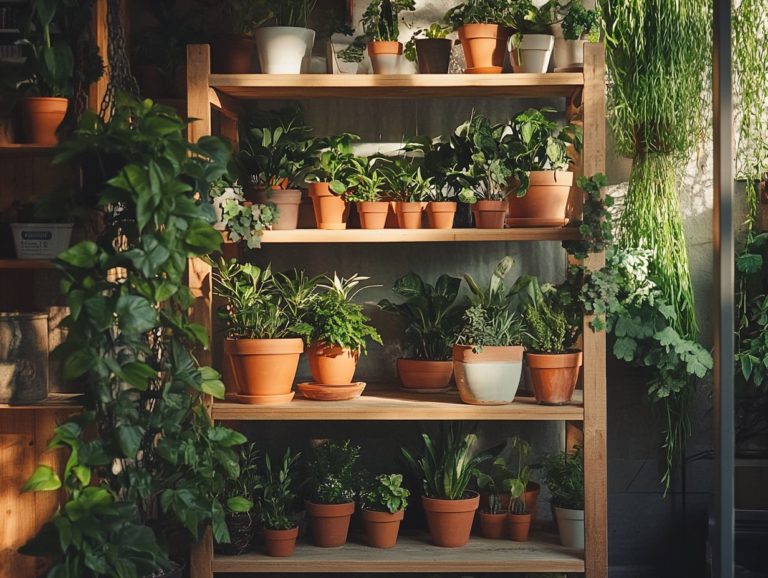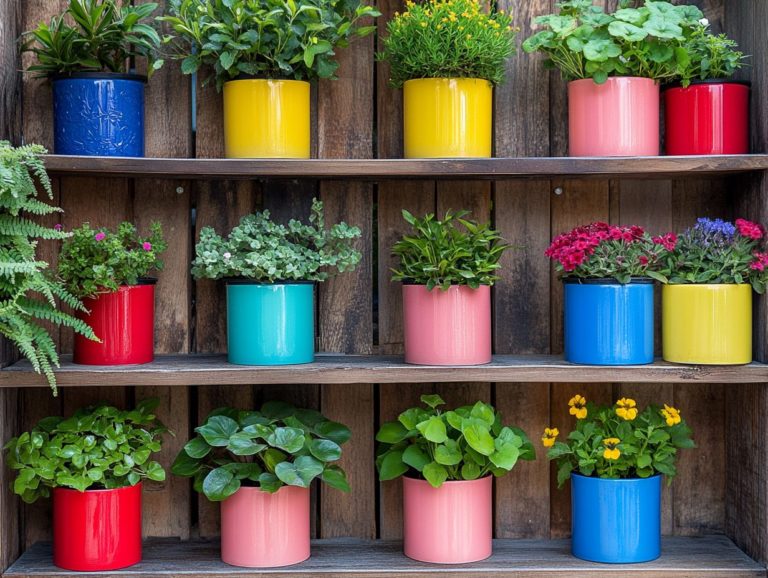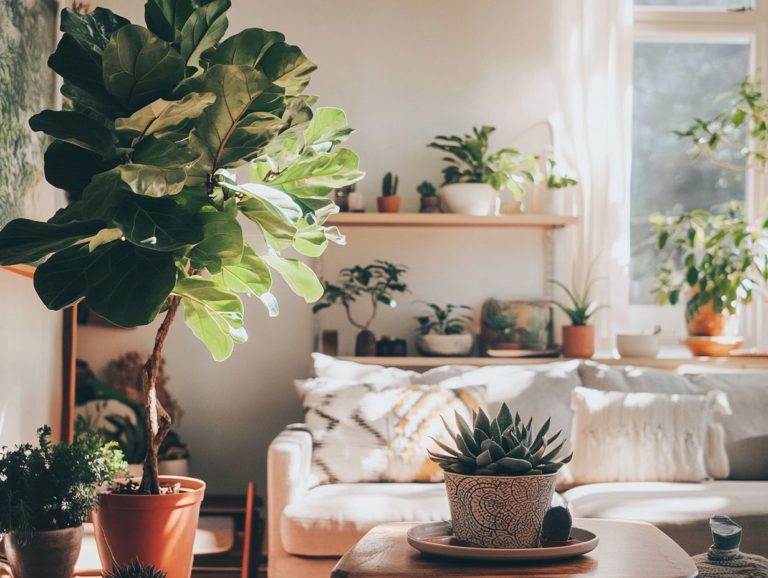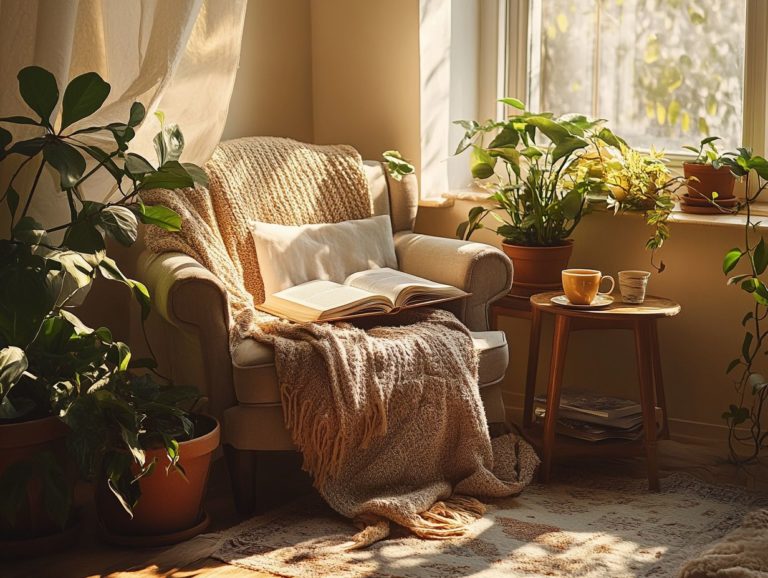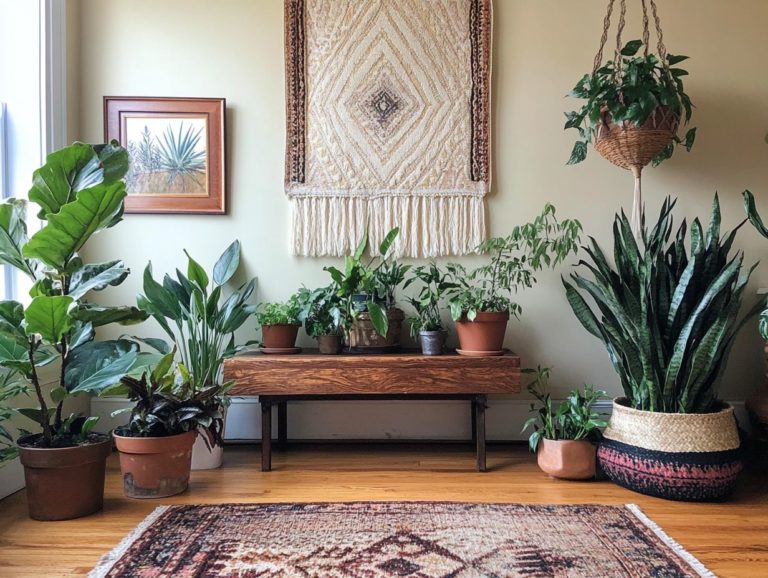Decorating with Indoor Plants on a Budget
Transforming your home with indoor plants can be an affordable endeavor.
Whether you re a seasoned plant parent or just dipping your toes into the world of greenery, you have a wealth of budget-friendly strategies at your fingertips to elevate your space.
From low-maintenance plant options to clever DIY projects and engaging plant swaps, this guide unveils creative ways to infuse your home with lushness without straining your finances.
Explore how you can cultivate an inviting and vibrant living environment while keeping your budget in check.
Let s get started on bringing vibrant greenery into your home!
Contents
- Key Takeaways:
- 1. Choose Low-Maintenance Plants
- 2. Discover Treasures at Thrift Stores and Garage Sales
- 3. DIY Planters and Pots
- 4. Propagate Your Own Plants
- 5. Use Repurposed Items as Planters
- 6. Join Plant Swapping Groups
- 7. Shop at Discount Stores
- 8. Grow Plants from Seeds
- 9. Take Advantage of Sales and Deals
- 10. Use Cuttings from Friends and Family
- 11. Repurpose Old Furniture as Plant Stands
- 12. Shop at Local Farmers’ Markets
- 13. Use Natural Light Instead of Artificial
- 14. Reuse and Recycle Plant Containers
- 15. Take Care of Your Plants to Avoid Replacing Them
- How Can Indoor Plants Enhance Your Home Decor?
- Frequently Asked Questions
- How can I decorate with indoor plants on a budget?
- What are some low-maintenance indoor plants that are also budget-friendly?
- Can I use fake plants to decorate on a budget?
- How can I incorporate indoor plants into my existing home decor?
- Are there any DIY decorating ideas for indoor plants on a budget?
- Can decorating with indoor plants on a budget have any health benefits?
Key Takeaways:
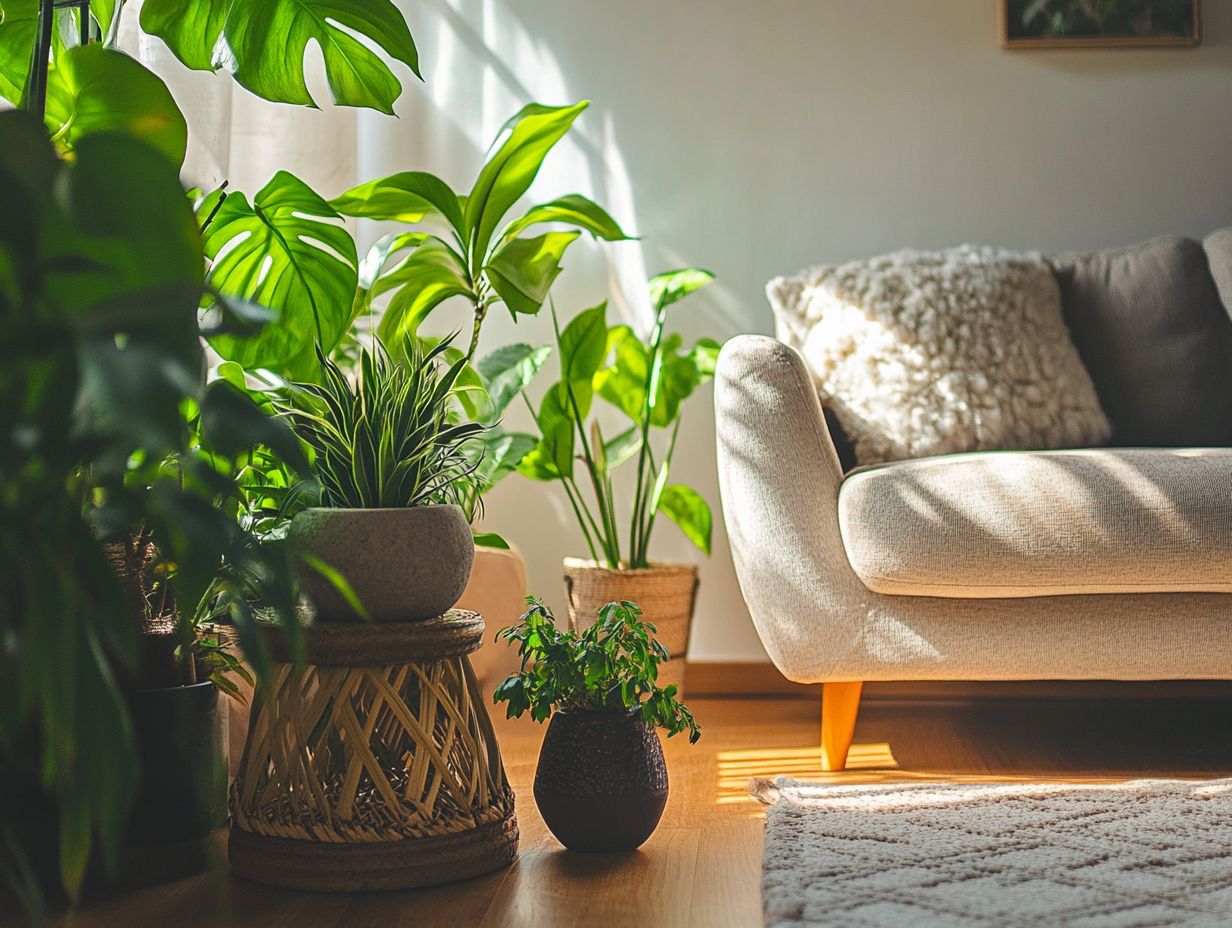
- Choose low-maintenance plants to save time and money on caring for them.
- Utilize thrift stores and garage sales for affordable and unique planters.
- DIY planters and pots using repurposed items to add a personal touch to your decor.
1. Choose Low-Maintenance Plants
In indoor gardening, low-maintenance plants like snake plants, pothos, and peace lilies simplify your care routine. They enhance your home s aesthetic without requiring extensive upkeep.
These plants thrive in different lighting conditions, with snake plants happily basking in low light and pothos eagerly adapting to brighter environments. Positioning them in cozy corners introduces greenery while cultivating a soothing ambiance, transforming your spaces into serene retreats.
Peace lilies, with their graceful white blooms, actively filter indoor air pollutants, contributing to a tranquil atmosphere. By incorporating these plants into your home, you enhance your living environment and boost your well-being, fostering a healthier, more inviting atmosphere for both yourself and your guests.
2. Discover Treasures at Thrift Stores and Garage Sales
Thrift stores and garage sales are your personal treasure troves, brimming with unique pots and vintage items that can transform your indoor gardening experience. Imagine curating diverse plant collections that elevate your greenery and enhance your home decor with wonderfully organic, imperfect vibes.
As you explore these sales, keep an eye out for delightful surprises, like charming plant misters or one-of-a-kind canisters for plant food, all available at a fraction of retail prices. Incorporating these accessories enriches the aesthetics of your plant displays and champions a sustainable approach to gardening.
By choosing to repurpose these finds, you align perfectly with your personal design journey, infusing your space with character and layers of storytelling. Every piece contributes to the narrative of your home, demonstrating how creativity and resourcefulness can harmoniously blend into everyday life.
3. DIY Planters and Pots
Creating DIY planters and pots allows you to infuse a personal touch into your indoor gardening endeavors. This lets you incorporate natural textures and materials that align with your unique aesthetic. Whether you opt for real plants or faux ones, you can elevate your living space into a true masterpiece.
By selecting a variety of materials such as reclaimed wood, vibrant ceramics, or even upcycled containers you can craft one-of-a-kind vessels that reflect your personal style. Consider employing techniques like macram , a technique of knotting cords, to fashion hanging planters that draw the eye upward, maximizing your vertical space. If a modern vibe is more your speed, geometric cement planters can seamlessly introduce sleek sophistication.
These custom creations cater to the specific needs of various indoor plants, ensuring proper drainage and lighting while adding layers of interest to your space. Transform a simple corner into a botanical sanctuary that truly feels like home.
4. Propagate Your Own Plants
Propagating your own plants is a rewarding and cost-effective way to expand your indoor collection. You can nurture baby plants from established favorites like monstera or jade plants, while perfecting your plant care skills.
Watching new growth emerge is exciting. You can experiment with various ways to create new plants from existing ones, such as water propagation or soil division, especially with resilient species like pothos and spider plants.
For instance, cut pothos vines into sections and place them in water. They ll develop roots in just a few weeks! Likewise, spider plants produce delightful offshoots called pups, which you can gently detach and replant.
Regularly check moisture levels and provide adequate light to ensure healthy growth. Plant propagation enhances your collection and fosters plant diversity, enriching ecosystems and supporting local biodiversity efforts.
5. Use Repurposed Items as Planters
Repurposing everyday items as planters is a delightful and sustainable way to pursue indoor gardening. Transform vintage containers or old furniture into functional plant stands that complement your houseplants and elevate your home decor.
Consider those old wooden crates you have lying around. Stacking them creates an eye-catching display that adds rustic charm to your space. Using teacups or mason jars adds a quirky flair and showcases your eco-friendliness.
Don t forget about vintage suitcases; when lined with suitable materials, they can become whimsical large-scale planters, perfect for cascading plants. This approach celebrates individuality and creativity in your home design.
It encourages a relaxed atmosphere while showcasing your unique style.
6. Join Plant Swapping Groups
Joining plant swapping groups cultivates a vibrant community of passionate indoor gardeners. You can share and exchange plants, enriching your collection while gaining invaluable insights on plant identification and care techniques.
These groups expand the variety of greenery in your living space and connect you with like-minded individuals who share your love for plants. By joining these communities, you can discover unique species that local stores may not offer.
The social interactions foster belonging and support. You can share tips, tricks, and experiences freely. Building relationships can lead to lifelong friendships while indulging in your passion for indoor gardening.
7. Shop at Discount Stores
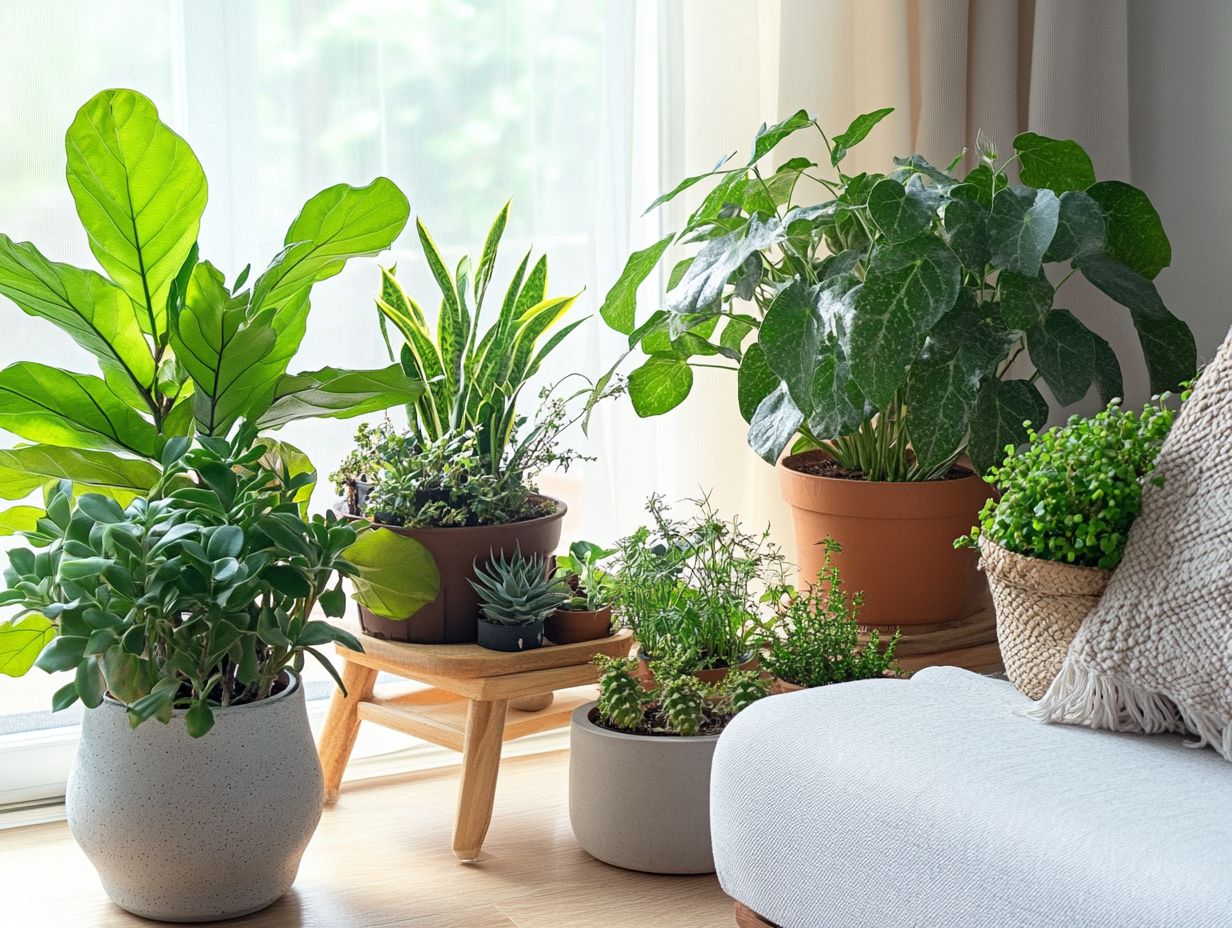
Shopping at discount stores can unveil remarkable treasures for your plants and house plant accessories. This allows you to cultivate your indoor garden with a delightful array of options that suit any budget without sacrificing quality or style.
As you browse these stores, look for resilient plant varieties like pothos, snake plants, and ZZ plants. These beauties are low-maintenance and adapt effortlessly to various indoor environments.
Don t forget to seek out accessories that can elevate your plant care routine like self-watering pots or stylish plant stands that enhance your space s aesthetic.
Check for drainage holes in planters, as proper drainage is crucial for nurturing healthy roots. Whether you’re a seasoned green thumb or just starting out, these tips will help you create a thriving indoor garden that breathes life into your home.
8. Grow Plants from Seeds
Growing your own plants from seeds is a rewarding experience that enhances your indoor garden. You’ll watch each seedling thrive, transforming your home into a green paradise.
To embark on this rewarding path, first, select the right seeds that reflect your personal preferences and the local climate. Don’t underestimate the importance of high-quality soil; rich, well-draining soil creates the perfect haven for germination. Regular attention is key. Provide the right amount of watering, light exposure, and fertilization for your young plants to flourish.
By choosing to grow from seeds, you ll discover a cost-effective way to cultivate a vibrant space while experiencing the joy of nurturing new life right from the ground up.
9. Take Advantage of Sales and Deals
Taking advantage of sales and deals at local garden centers can significantly elevate your plant collection. This allows you to expand your indoor garden with quality house plants and accessories all while keeping your budget intact.
It s not merely about snagging lower prices; approaching these sales with a strategic mindset is essential. Consider your home design aesthetic beforehand to make informed purchasing decisions that beautifully complement your existing decor.
Begin by envisioning the colors, textures, and themes that resonate with your space. This ensures that the plants you choose thrive while enhancing the overall ambiance of your home. Regular visits to these sales give you a better sense of timing and expose you to an exciting variety of new plants.
Keep a list of preferred species to stay focused amidst the overwhelming array of choices.
10. Use Cuttings from Friends and Family
Utilizing cuttings from friends and family elevates your indoor houseplant collection and fortifies social connections. Imagine swapping stories of care and growth while sharing valuable tips on nurturing these cherished green companions.
This process of propagation, or growing new plants from cuttings, can be both rewarding and simple, especially with plants like pothos, spider plants, and succulents, which flourish when grown from cuttings. Select a healthy segment from the parent plant, ensuring it boasts at least a couple of leaves.
You can either place the cutting in water or directly into soil, depending on the species. Position it in a warm, bright spot. Just remember to keep it moist and provide occasional nutrients as those roots begin to establish.
This shared experience cultivates not only your collection but also a sense of camaraderie among plant enthusiasts. By exchanging experiences, tips, and care routines, you create a vibrant, supportive network that enriches your gardening adventure.
11. Repurpose Old Furniture as Plant Stands
Repurposing old furniture into stylish plant stands adds height and dimension to your indoor garden and infuses your home decor with a unique flair. It showcases your creativity while providing functional space for your leafy companions.
When selecting pieces for this transformation, seek out sturdy items like side tables or bookcases that can comfortably support the weight of your potted greenery. Consider the existing color palette and style of your home to ensure that the repurposed furniture blends in or creates a striking contrast against your interior.
Incorporating plants with varying textures and heights can craft an engaging visual dynamic. The interplay between your furniture design and plant aesthetics enhances the warmth of a room and directs the eye, creating focal points that elevate your living space to new heights.
12. Shop at Local Farmers’ Markets
Shopping at local farmers’ markets lets you discover a variety of plants and fresh flowers. You’ll also find unique plant accessories.
These markets showcase vibrant selections of herbs like basil, mint, and rosemary. You can also find eye-catching potted succulents and seasonal flowers. By exploring these local treasures, you can introduce unique varieties into your indoor green spaces and promote variety in plants within your environment.
Engaging with growers lets you ask about their growing methods and care tips, enriching your knowledge and leading to healthier plants. This connection to local agriculture nurtures your personal garden and can inspire sustainable practices that benefit the entire community.
13. Use Natural Light Instead of Artificial
Utilizing natural light instead of artificial sources significantly enhances the health of your indoor plants. This caters to their specific sunlight needs while adding a natural, unique charm to your home.
To assess the natural light in your space, observe how sunlight flows into each room throughout the day. Take note of areas that bask in direct sunlight, those that enjoy partial light, and where shadows linger.
This insight helps you position your plants perfectly! For instance, succulents and cacti thrive in bright, direct light and work well near south-facing windows. In contrast, ferns and snake plants prefer lower light conditions and flourish in areas with filtered daylight.
By arranging your greenery according to these specific needs, each plant receives the optimal care they deserve, enriching your living space with beauty and life.
14. Reuse and Recycle Plant Containers
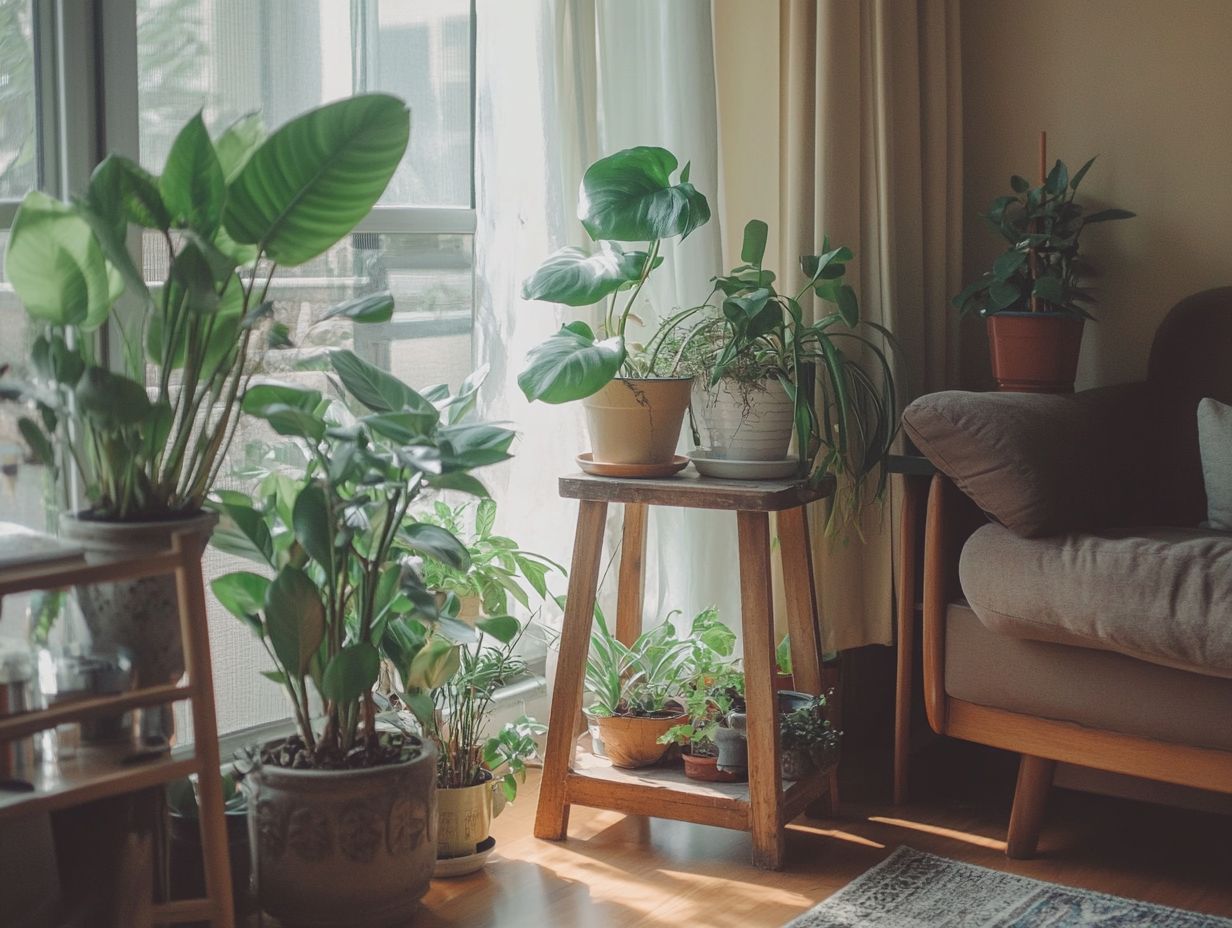
Reusing and recycling plant containers champions eco-friendly practices and enables you to craft a stunning and diverse collection of planters. This elevates the allure of your indoor garden while being considerate of the environment.
By embracing a creative mindset, you can transform everyday items like old tin cans, glass jars, and discarded wooden crates into distinctive homes for your cherished plants. This approach curbs waste and infuses your space with unique personality and charm.
Engaging in these sustainable gardening practices contributes to a healthier planet by minimizing the need for new resources and fostering a cycle of reuse. Thoughtful selection of containers cultivates a harmonious environment that reflects nature’s beauty and enhances your environmental awareness.
15. Take Care of Your Plants to Avoid Replacing Them
Proper plant care is vital for the longevity of your indoor houseplants. It allows them to thrive and enhance your living space without the tedious task of constant replacements.
To care for your plants effectively, master the art of timing know when to water, how to choose the right fertilizer, and recognize the benefits of occasional misting. Regularly check the moisture level in the soil; overwatering can lead to root rot, while underwatering may cause wilting.
When fertilizing, using a balanced plant food during the growing season ensures your plants receive essential nutrients. This promotes lush foliage and vibrant blooms. Incorporating a plant mister helps maintain humidity levels, especially for tropical varieties that thrive in moist conditions.
Being attentive to signs of stress in your plants is key! Yellowing leaves or stunted growth often signal underlying issues that require your immediate attention. By caring for your plants properly, you can enjoy their beauty longer and avoid frequent replacements. Don’t wait start today!
How Can Indoor Plants Enhance Your Home Decor?
Indoor plants can elevate your home decor. They introduce natural textures, colors, and shapes.
Plants create a serene atmosphere that promotes tranquility. They also reflect your personal style and aesthetic throughout your space.
Incorporating plants stylishly can be achieved through various options. Consider vertical gardens that transform bare walls into stunning green displays, inviting nature indoors even in limited spaces.
Terrariums offer a creative way to showcase plants with miniature ecosystems, requiring minimal maintenance. Choosing decorative pots can enhance the overall design, allowing for a seamless blend of greenery with your existing decor elements.
The mental health benefits of indoor plants are substantial. They purify the air and help reduce stress, uplift your mood, and stimulate creativity.
By integrating these elements thoughtfully, you can significantly enhance both the aesthetics and atmosphere of any living space.
What Are Some Easy Ways to Incorporate Plants into Your Home?
Incorporating plants into your home is a delightful endeavor. You can achieve this effortlessly through simple yet effective strategies.
Consider placing tall house plants in cozy corners or utilizing elegant plant stands. Artfully arranging leafy varieties on windowsills can elevate the visual allure of your indoor gardening efforts.
Selecting a diverse array of plant types from charming succulents to lush ferns creates a dynamic visual experience. Adding decorative pots or hanging planters infuses character and style into your space, transforming it into a tranquil oasis.
For moments when sunlight is scarce, choose low-light plants like pothos or snake plants. This ensures that greenery can thrive in any environment.
You can also incorporate stylish accessories such as chic watering cans or sleek gardening tools. This enhances your decor, making plant care a seamless and enjoyable aspect of your daily life.
What Are the Benefits of Having Indoor Plants?
Having indoor plants brings a wealth of benefits. They enhance air quality and well-being while creating a natural aesthetic that fosters tranquility.
Research shows that plants like the Spider Plant, Peace Lily, and Snake Plant are champions at purifying the air. They filter out pesky pollutants such as formaldehyde and benzene.
But it’s not just about improving your physical space. The presence of greenery is linked to lower stress levels and heightened feelings of calm and happiness.
Nurturing these plants can give you a sense of purpose and a connection to nature, evoking positive emotions. Studies indicate that incorporating natural elements indoors can enhance your concentration and mood, significantly boosting your overall mental health.
How Can You Create a Cohesive Look with Different Plant Types?
Creating a cohesive look with various plant types requires selecting varieties that beautifully complement each other. Consider their color, texture, and height.
This thoughtful approach elevates your home design and showcases the diversity of plants in an engaging visual experience.
To achieve this harmonious arrangement, consider the size, color palette, and leaf shapes of the plants you choose. Taller plants can serve as stunning focal points, while shorter ones contribute to a lush understory.
Incorporating a mix of vibrant and muted greens adds depth. Varying leaf shapes keeps the eye moving and enhances visual interest.
It’s essential to ensure your selected plants share similar care requirements, such as light and watering needs. This simplifies maintenance and fosters a thriving indoor ecosystem.
Ultimately, a thoughtful arrangement can transform any space into a vibrant sanctuary. Start your indoor gardening journey today and experience the transformation!
What Are Some Common Mistakes to Avoid When Decorating with Plants?
When you’re decorating with indoor plants, steering clear of common pitfalls like overwatering and neglecting sunlight requirements can greatly impact the success of your indoor gardening. Choosing the wrong pot size can also affect the overall health of your plants.
These missteps not only slow down growth but can also detract from the aesthetic charm of your space. For example, overwatering can lead to unsightly root rot, which is when the roots of the plant decay due to excess water. Insufficient sunlight may result in leggy growth, where the plants reach for light and become tall and weak.
It’s crucial to grasp the specific needs of each plant. Some flourish in bright, direct light, while others prefer a more shaded sanctuary. Selecting the right pot size is equally important, as it ensures the roots have enough room to grow without feeling cramped, preventing development from stalling.
By paying attention to these key factors, you can cultivate a vibrant indoor oasis that enhances your decor and breathes life into your home.
Frequently Asked Questions
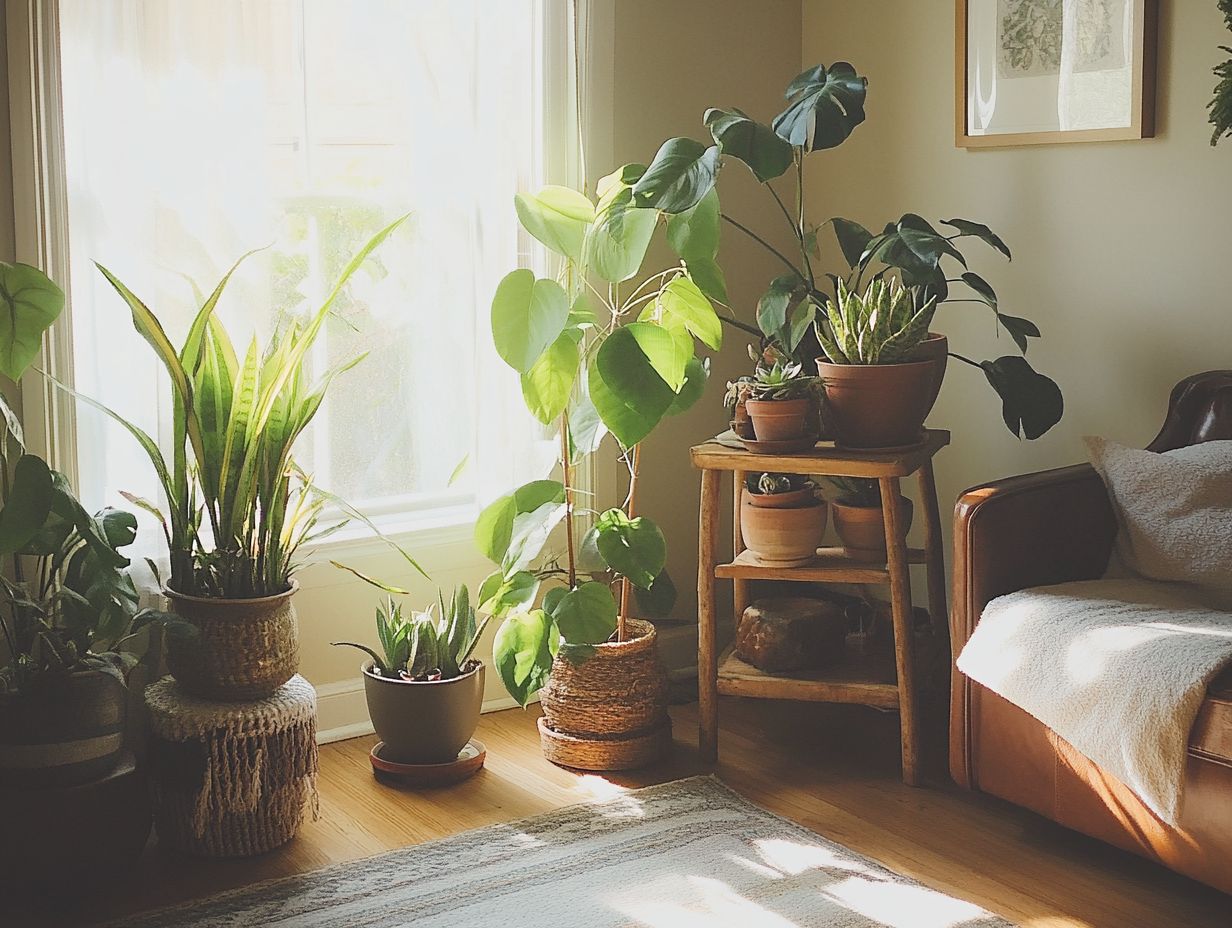
How can I decorate with indoor plants on a budget?
There are several ways to decorate with indoor plants on a budget. One option is to repurpose items you already have, such as using mason jars as planters. You can also look for affordable plants at local nurseries or online. You can also propagate plants from cuttings instead of buying new ones.
What are some low-maintenance indoor plants that are also budget-friendly?
Some low-maintenance indoor plants that won’t break the bank include spider plants, pothos, succulents, and cacti. These plants require minimal care and can thrive in various lighting conditions, making them perfect for decorating on a budget.
Can I use fake plants to decorate on a budget?
Yes, fake plants can be a budget-friendly option for decorating with indoor plants. Look for high-quality fake plants that closely resemble real ones. You can mix them in with live plants for a more natural look. You can even DIY your own fake plants using materials like tissue paper or felt.
How can I incorporate indoor plants into my existing home decor?
Transform your space by adding indoor plants that match your decor style! For example, if you have a bohemian-inspired space, opt for plants with a wild and free-flowing aesthetic. Use planters in different shapes, sizes, and colors to add visual interest to your decor.
Are there any DIY decorating ideas for indoor plants on a budget?
Yes, there are many DIY decorating ideas for indoor plants on a budget. You can create your own planters using recycled materials like tin cans or old jars. Make your own macrame hangers or shelves to display your plants. Pinterest and craft blogs are great resources for finding budget-friendly DIY ideas.
Can decorating with indoor plants on a budget have any health benefits?
Yes, decorating with indoor plants on a budget can have several health benefits. Plants can purify the air, reduce stress levels, and improve overall well-being. Having plants in your home can also boost your mood and increase productivity. Plus, budget-friendly plants are easy to care for, making it easier to reap these benefits.


